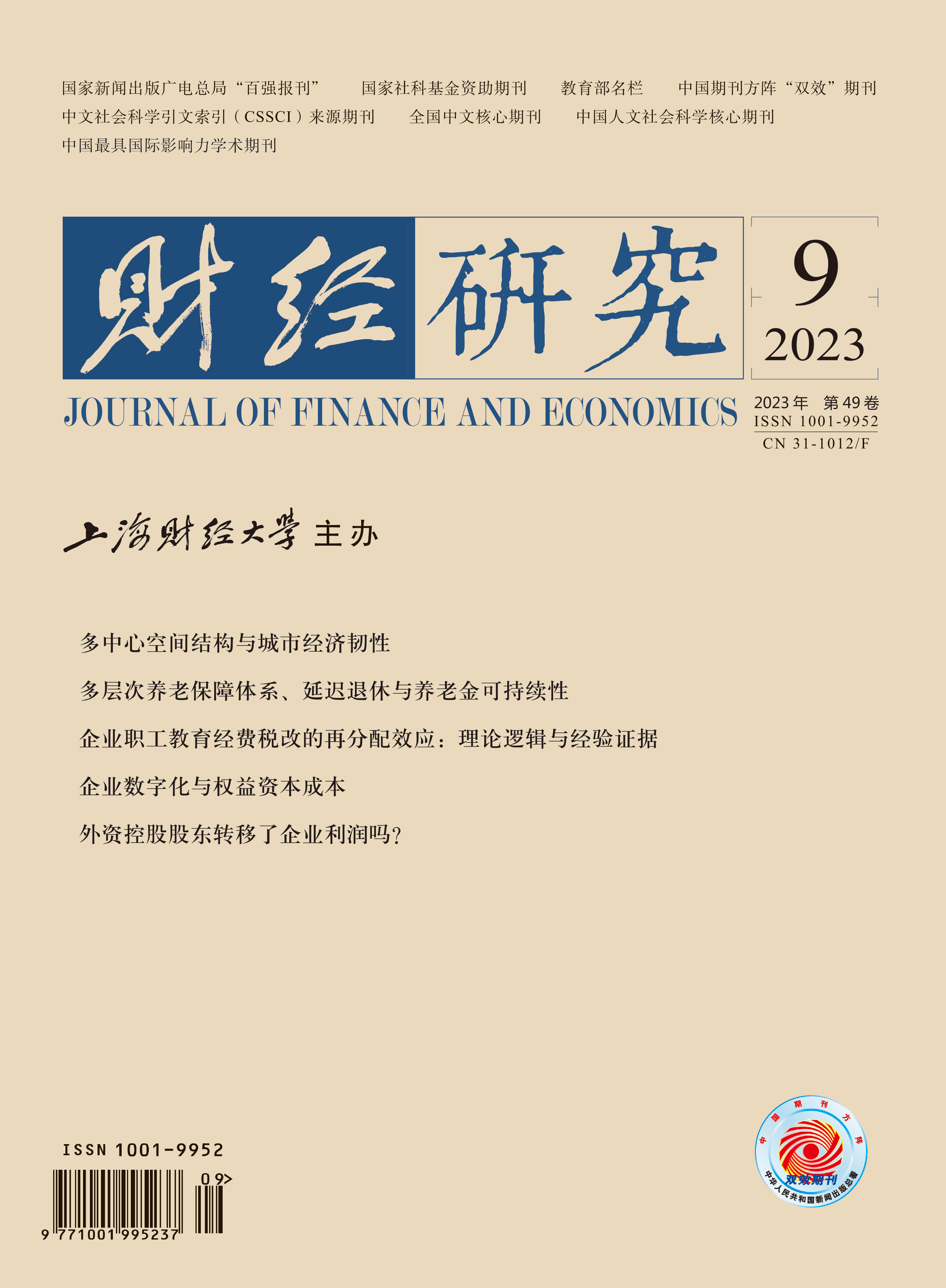市场准入负面清单制度的实施有利于营造公平的竞争环境,激发市场竞争活力。作为关键性战略信息,创新信息的披露兼具成本与收益,而在负面清单政策的冲击下,企业究竟会顾及专有成本而抑制创新信息披露,还是出于战略性考虑,增加创新信息披露呢?基于微观企业创新文本信息数据,文章对这一问题进行了考察,研究发现,负面清单制度的实施有利于增加企业创新信息披露以发挥其战略性价值。而横截面检验发现,当创新信息披露成本更低或披露收益更高时,负面清单制度对企业创新信息披露的促进作用更显著。机制分析则表明,管理层竞争感知增强与企业风险承担能力提升是上述影响的关键作用路径。此外,对同行信息外溢效应进行检验发现,同行创新信息披露具有显著的外部性,有利于改善总体的创新信息披露环境,并提升目标企业创新水平。文章从企业创新信息披露环境的视角考察了负面清单政策的微观效应,为我国增强市场主体活力、优化创新信息环境提供了直接的政策建议。
负面清单制度与企业创新信息披露
摘要
参考文献
1 陈升, 李兆洋. 产业负面清单制定及其管理模式研究[A]. 第十届中国软科学学术年会论文集[C]. 北京: 中国软科学研究会. 北京: 中国软科学研究会, 2015.
2 程新生, 郑海埃, 程昱. 创新信息披露、分析师跟踪与市场反应研究[J]. 科研管理,2020,(1):161−173. DOI:10.19571/j.cnki.1000-2995.2020.01.016
3 邓慧慧, 赵家羚. 地方政府经济决策中的“同群效应”[J]. 中国工业经济,2018,(4):59−78. DOI:10.19581/j.cnki.ciejournal.2018.04.004
6 李建标, 赵爱莉, 王静. 基于潜在竞争者的公司信息披露策略研究−实验室实验的检验[J]. 南开管理评论,2015,(1):37−44. DOI:10.3969/j.issn.1008-3448.2015.01.005
7 李姝, 杜亚光, 张晓哲. 同行MD&A语调对企业创新投资的溢出效应[J]. 中国工业经济,2021,(3):137−155. DOI:10.19581/j.cnki.ciejournal.2021.03.008
8 李岩琼, 姚颐. 研发文本信息: 真的多说无益吗?−基于分析师预测的文本分析[J]. 会计研究,2020,(2):26−42. DOI:10.3969/j.issn.1003-2886.2020.02.003
9 刘静, 王克敏. 同群效应与公司研发−来自中国的证据[J]. 经济理论与经济管理,2018,(1):21−32. DOI:10.3969/j.issn.1000-596X.2018.01.006
10 陆蓉, 王策, 邓鸣茂. 我国上市公司资本结构“同群效应”研究[J]. 经济管理,2017,(1):181−194. DOI:10.19616/j.cnki.bmj.2017.01.012
11 罗福凯, 李启佳, 庞廷云. 企业研发投入的“同侪效应”检验[J]. 产业经济研究,2018,(6):10−21. DOI:10.13269/j.cnki.ier.20181122.010
14 王雄元, 喻长秋. 专有化成本与公司自愿性信息披露−基于客户信息披露的分析[J]. 财经研究,2014,(12):27−38. DOI:10.16538/j.cnki.jfe.2014.12.008
16 吴非, 黎伟. 税收激励与企业绿色转型−基于上市企业年报文本识别的经验证据[J]. 财政研究,2022,(4):100−118. DOI:10.19477/j.cnki.11-1077/f.2022.04.006
19 张韩, 王雄元, 张琳琅. 市场准入管制放松与供给侧去产能−基于负面清单制度试点的准自然实验[J]. 财经研究,2021,(7):93−107. DOI:10.16538/j.cnki.jfe.20210416.403
20 张宗新, 张晓荣, 廖士光. 上市公司自愿性信息披露行为有效吗?−基于1998—2003年中国证券市场的检验[J]. 经济学(季刊),2005,(1):369−386. DOI:10.13821/j.cnki.ceq.2005.01.013
21 赵颖. 中国上市公司高管薪酬的同群效应分析[J]. 中国工业经济,2016,(2):114−129. DOI:10.19581/j.cnki.ciejournal.2016.02.009
23 周泽将, 汪顺, 张悦. 知识产权保护与企业创新信息困境[J]. 中国工业经济,2022,(6):136−154. DOI:10.3969/j.issn.1006-480X.2022.06.008
24 Aghion P, Bloom N, Blundell R, et al. Competition and innovation: An inverted-U relationship[J]. The Quarterly Journal of Economics,2005,120(2): 701−728.
25 Anton J J, Yao D A. The sale of ideas: Strategic disclosure, property rights, and contracting[J]. Review of Economic Studies,2002,69(3): 513−531. DOI:10.1111/1467-937X.t01-1-00020
26 Bartelsman E, Haltiwanger J, Scarpetta S. Cross-Country differences in productivity: The role of allocation and selection[J]. American Economic Review,2013,103(1): 305−334. DOI:10.1257/aer.103.1.305
27 Bond P, Zeng Y. Silence is safest: Information disclosure when the audience’s preferences are uncertain[J]. Journal of Financial Economics,2022,145(1): 178−193. DOI:10.1016/j.jfineco.2021.08.012
28 Cao S S, Ma G, Tucker J W, et al. Technological peer pressure and product disclosure[J]. The Accounting Review,2018,93(6): 95−126. DOI:10.2308/accr-52056
29 Christensen H B, Liu L Y, Maffett M. Proactive financial reporting enforcement and shareholder wealth[J]. Journal of Accounting and Economics,2020,69(2-3): 101267. DOI:10.1016/j.jacceco.2019.101267
30 Darrough M N, Stoughton N M. Financial disclosure policy in an entry game[J]. Journal of Accounting and Economics,1990,12(1-3): 219−243. DOI:10.1016/0165-4101(90)90048-9
31 Djankov S, La Porta R, Lopez-De-Silanes F, et al. The regulation of entry[J]. The Quarterly Journal of Economics,2002,117(1): 1−37. DOI:10.1162/003355302753399436
32 Glaeser S A, Landsman W R. Deterrent disclosure[J]. The Accounting Review,2021,96(5): 291−315. DOI:10.2308/TAR-2019-1050
33 Hall B, Helmers C, Rogers M, et al. The Choice between formal and informal intellectual property: A review[J]. Journal of Economic Literature,2014,52(2): 375−423. DOI:10.1257/jel.52.2.375
34 Huang S, Ng J, Ranasinghe T, et al. Do innovative firms communicate more? Evidence from the relation between patenting and management guidance[J]. The Accounting Review,2021,96(1): 273−297. DOI:10.2308/tar-2017-0082
35 Huang Y, Jennings R, Yu Y. Product market competition and managerial disclosure of earnings forecasts: Evidence from import tariff rate reductions[J]. The Accounting Review,2017,92(3): 185−207. DOI:10.2308/accr-51558
36 Jones D A. Voluntary disclosure in R&D-intensive industries[J]. Contemporary Accounting Research,2007,24(2): 489−522. DOI:10.1506/G3M3-2532-514H-1517
37 Kim J, Valentine K. The innovation consequences of mandatory patent disclosures[J]. Journal of Accounting and Economics,2021,71(2-3): 101381. DOI:10.1016/j.jacceco.2020.101381
38 Li X. The impacts of product market competition on the quantity and quality of voluntary disclosures[J]. Review of Accounting Studies,2010,15(3): 663−711. DOI:10.1007/s11142-010-9129-0
39 Li Y H, Lin Y P, Zhang L D. Trade secrets law and corporate disclosure: Causal evidence on the proprietary cost hypothesis[J]. Journal of Accounting Research,2018,56(1): 265−308. DOI:10.1111/1475-679X.12187
40 Madsen J M, McMullin J L. Economic consequences of risk disclosures: Evidence from crowdfunding[J]. The Accounting Review,2020,95(4): 331−363. DOI:10.2308/accr-52641
41 Merkley K J. Narrative disclosure and earnings performance: Evidence from R&D disclosures[J]. The Accounting Review,2014,89(2): 725−757. DOI:10.2308/accr-50649
引用本文
张悦, 许永斌, 汪顺. 负面清单制度与企业创新信息披露[J]. 财经研究, 2023, 49(9): 124-137.
导出参考文献,格式为:
下一篇:信息化强征管与自觉纳税遵从





 4925
4925  3618
3618

